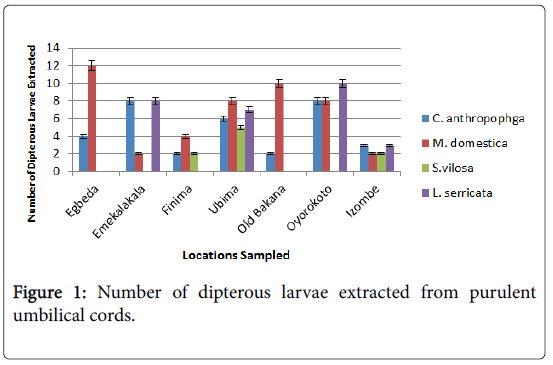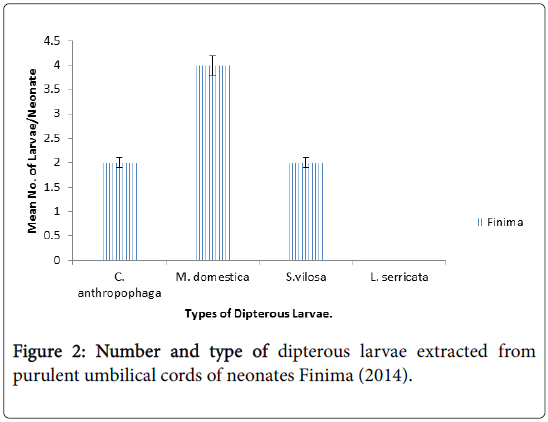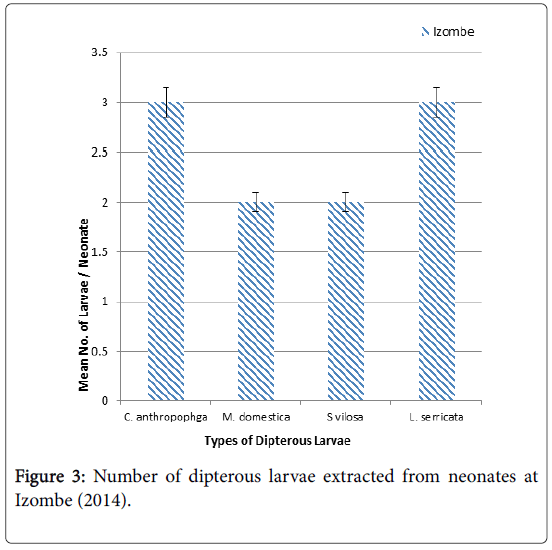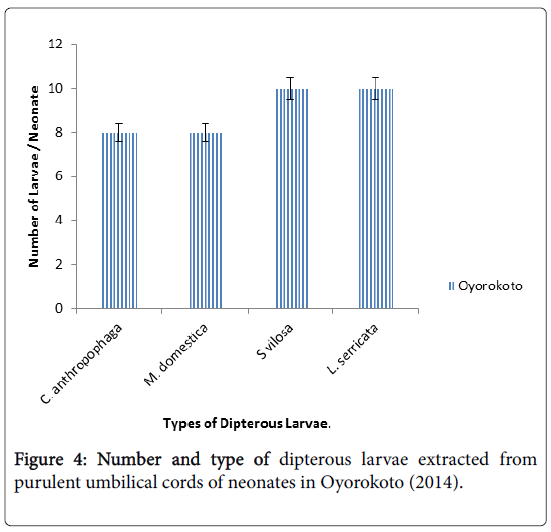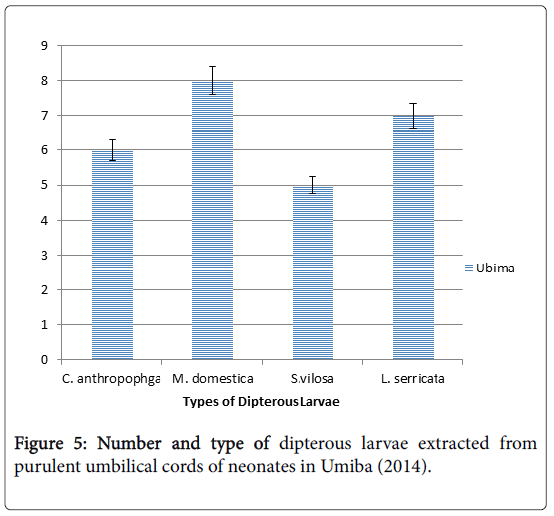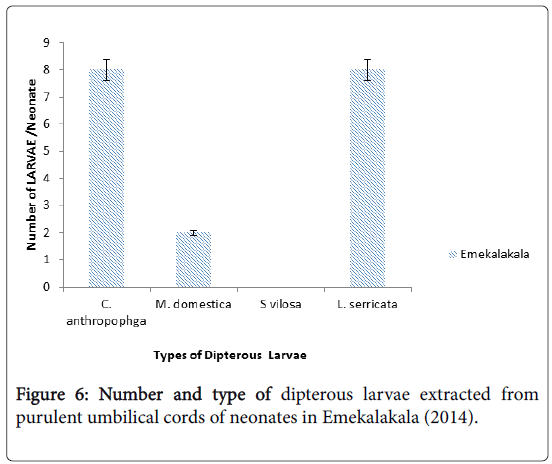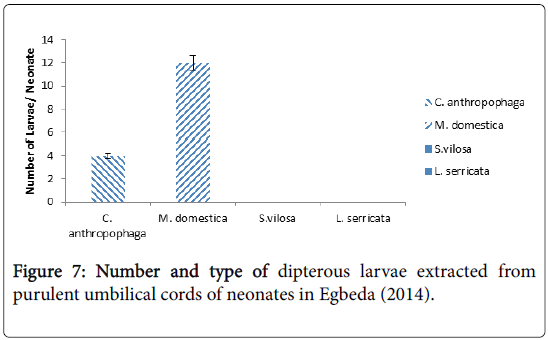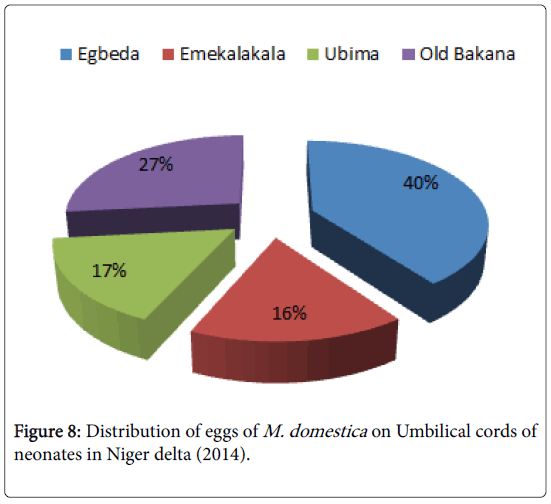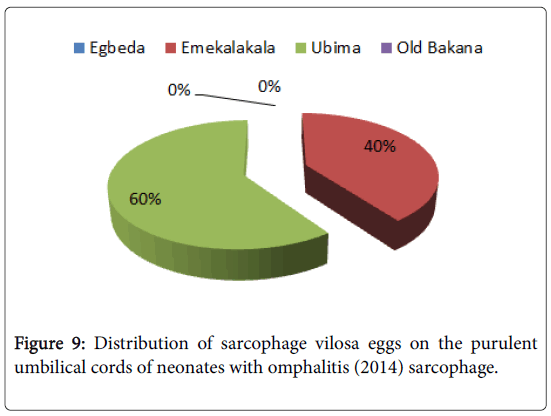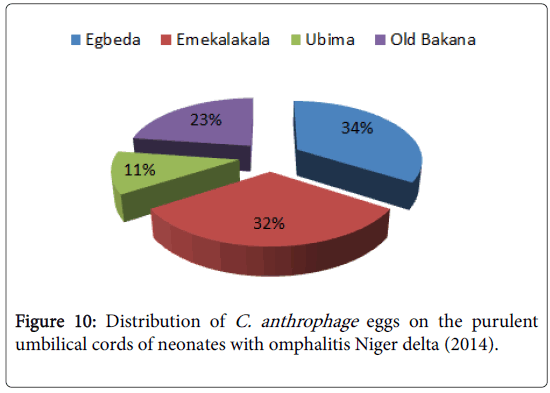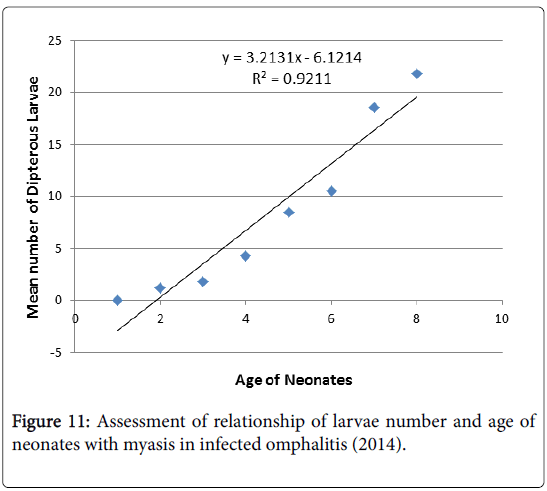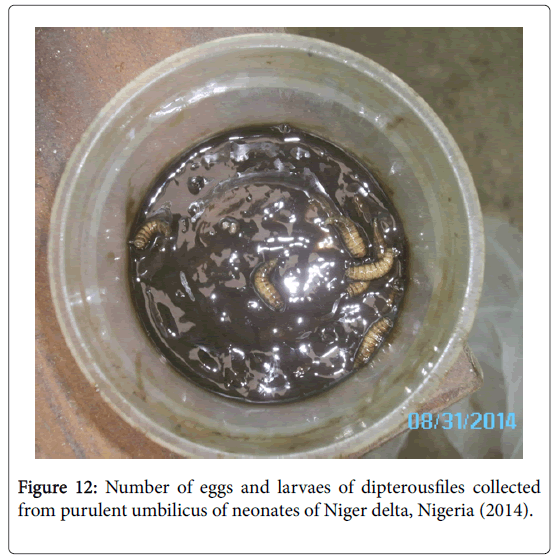A New Trend of Omphalitis Complicated With Myiasis in Neonates of the Niger Delta, Nigeria
Received: 06-Jan-2016 / Accepted Date: 09-Mar-2016 / Published Date: 16-Mar-2016 DOI: 10.4172/2161-1165.1000231
Abstract
We report for the first time the Omphalitis infection in some neonates of the Niger Delta that was complicated with dipterous larval infections (myiasis) of their purulent umbilical cords. Unhygienic practices coupled with traditional ways of handling newborn babies and the application of non-sterile instruments during and after delivery at the rural settings promoted the aforementioned complications. Among 55 neonates examined for sepsis Omphalitis across the Niger Delta, 12 (21.8%) had dipterous larvae in their umbilical cords and stumps. The focus of the study was to assess the dermatological data of Omphalitis complicated with myiasis in newborns and establish the presence of other causes other than microorganisms in umbilical cords. Neonates of the age bracket (4-6 days old) showed higher infection rate with living larvae in decomposing umbilical cords. Dipterous larvae were obtained from three sites; the umbilical cords, umbilical stumps and from the skin around the stumps. Some eggs were also recorded in some of the aforementioned sites sampled. Data showed in neonates of 4-6 days old varied overall infection rates. Dermatological data showed in neonates overall infection rates from different locations of the Niger Delta. An overall infection rate of total eggs of dipterous flies deposited by Sarcophaga vilosa on the cords and stumps was 40% in Emekalakala (CI 95%, 37.2-40.4); in Ubima (CI 95%, 58.5-60. 2). No eggs of S. vilosa were found in other locations. At other locations, infection rates by Musca domestica attracted 40% in Old Bakana (CI 95%, 38.3- 40.2), 27% (CI 95%, 25.5-27.2). Infection rates caused by eggs of Cordylobia anthrpophaga in Ubima neonates was 34% (CI 95%, 32.1-34.5) and 34% in Egbeda (CI 95%, 32.3-34.5) and 32% in Emekalakala (CI 95%, 31.4-32.5).
Keywords: Omphalitis infection; Neonates; Nigeria; Myiasis
164540Introduction
Omphalitis is defined as infection of the umbilical stump in the newborn. It primarily affects neonates, in whom the combination of the umbilical stump and decreased immunity presents an opportunity for infection. It is rarely reported outside the neonatal period. Varieties of congenital conditions predispose to infection of the umbilical stump and are also among the differential diagnoses to consider for the presentation.
Omphalitis may extend into the portal vein and result in various acute complications requiring medical as well as surgical interventions. Although this condition is uncommon in developed countries, it remains a significant cause of morbidity and mortality in Africa and other parts of the world where health care is less readily available. Umbilical cord infection contributes significantly to newborn infection and neonatal mortality in Africa, especially for infants delivered at home without skilled birth attendants and under unhygienic conditions.
Myiasis is defined as the invasion of the Vertebrates organs and tissues with living dipterous larvae which feed on the invaded sites, growing and metamorphosing until pupation when they leave the victim’s body to pupate outside in the soil or attached to clothing, beddings, plants or other objects.
It had been reported in the breasts of nursing mothers [1], in neonates [2]. It was also reported in rural women who used recycled pieces of cloth during their menses [3]. Other workers [4] had reported on myiasis. Myiasis is a neglected disease of most humid parts of Nigeria. Research studies had also reported its presence in other parts of Nigeria [5].
In most rural settings of Nigeria, myiasis is under reported and locally treated with victims not attending to hospitals for medical and to be educated on how to avoid its infection.
Notable amongst the dipterous flies that cause myiasis in the Niger Delta include Cordylobia anthropophaga, Lucilia sericata , Sarcophaga vilosa and also Musca domestica which is a facultative agent. Human furuncular myiasis had been studied in the Niger Delta ecological zone and reported [2,5].
Our findings showed that women, children, and infants were commonly affected by furuncular myiasis irrespective of skin color, age, blood group, race, sex, genotype, etc. Infection due to C.anthropophaga occurs throughout the year; the rate of infection is higher during the rainy season (when humidity is normally higher) than the dry seasons [5].
Niger Delta: The data presented here provides good travel information to the Niger Delta region as well as other parts of Nigeria. Human furuncular myiasis affects neonates ranging from 3 to 11 days old, children, and adults in Nigeria.
C. anthropophaga maggots penetrate all types of skin; people with albinism, white skin, and black skin. Some of the factors that affect the distribution include unhygienic situations, high humidity, poverty, and use of soiled clothes. Details of our findings are presented
Cordylobia infection is a neglected disease of the Niger Delta region. Therefore, there was the need to know the spread and factors that promote spreading as well as populations of the myiasis-causing agent in the Niger Delta. The data presented here provides good travel information to the Niger Delta region as well as other parts of Nigeria.
Human furuncular myiasis affects neonates ranging from 3 to 11 days old, children, and adults in Nigeria. C. anthropophaga maggots penetrate all types of skin; people with albinism, white skin, and black skin. Some of the factors that affect the distribution include unhygienic situations, high humidity, poverty, and use of soiled clothes [5].
Dipterous flies of forensic importance and those of myiasis-causing agents [2,3,5]. We attracted to foul smell of umbilical cords and deposit their eggs on such sites. Figures showed the number of eggs recovered from decaying or infected umbilical cords
Omphalitis is uncommon in developed countries, with an incidence of 0.2–0.7% [1]. The incidence in developing countries has been quoted to be between 2 and 7 in every 100 live births [2,3].
However, the incidence is even higher in communities that practiced application of non-sterile home remedies to the cord. In one study of neonates admitted to an African general pediatric ward, omphalitis accounted for 28% of neonatal admissions [4]. Hospitalbased studies estimate that 2-54 babies per 1000 births will develop omphalitis [5]. However, one report from Tanzania [6] found a rate of 1.7% among babies of 3,262 women.
Method and Material
Sampling areas/Design
The study was carried out in the rainy season of 2014 (August- October) in the following locations of the Niger Delta of Nigeria, Egbeda, Finima, Emekalakala, Izombe, Oyorokoto, Ubima and Old Bakana. The aforementioned locations include both the coastal and uplands parts of the Niger Delta. People within the locations have different occupations; however, they are mostly fishermen, fish-sellers, traders and farmers in the rural settings.
Ethical clearance was sought from the Department of Medical Laboratory Science of the Rivers State University of Science and Technology, Port Harcourt before commencing the study. We also sought and obtained permissions from parents of the neonates who also gave their consent prior to examination of neonates.
We received reports of cases of umbilical cords with purulent odor during the rainy season of 2014 and decided to visit such homes. Our sampling was purposive and we sampled according to observations after the examination of the umbilical cords, stumps and skin around the stumps. We carried out this study in areas reported with cases of Omphalitis in neonates only.
Their age range was between 0-8 days old. We considered cases with purulent or foul-smelling situations, bruising of skin, and skin necrosis. The Samplers wore hand gloves and masks to cover their mouths and noses. Our sampling team was made up two health officers, four Post Graduate students of Medical Entomology students and two academic researchers for each of the for the eight locations in the Niger Delta.
Each personnel wore a white laboratory coat and were provided with sterile instruments; forceps, spatula, cotton and glass Petri dishes and vials for the extraction of eggs and larvae during sampling, each umbilical cord was examined for eggs and larvae of dipterans (flies with a pair of wings).
Sampling was carried out weekly (7am-9am) for one month depending on whether there were new reports or not, in cases of repeated infections, sampling continued and we obtained mean values on the eggs and/or larvae. Situations where we sampled just once did not have mean values and the results were presented as it were.
Statistical analysis
Statistical analyses were performed using SPSS software. Univariate Analysis of Variance (ANOVA) and Duncan’s Multiple Range Test (DMRT) was established. Student’s Newman Keule test (a furtherance of DMRT) was used in establishing significant differences in the number of eggs and larvae extracted from neonate’s umbilical cords in different age groups of neonates.
T-test analysis was used to assess significant difference between number of larvae from the umbilical cords and those from the stumps. Also a regression analysis was done to investigate a relationship between the age of neonates and larval number in the umbilical cords.
Results
Results showed locations sampled for rare cases of Omphalitis with Larvae in the purulent umbilical cords during the rainy season of 2014 (Figure 1).
A closer examination of the myiasis-causing agents at each of the sampled locations showed the population of M. domestica in purulent umbilical cords significantly higher in Finima town, Figure 1 showed that larvae of Musca domesticacollected from Egbeda a rural village were significantly higher than those of other locations in 2014 (D.M.R.T; P< 0.05).
M. domestica populations were significantly higher than the notorious myiasis-causing agents of C. anthropophaga and L. sericata . There was no significant difference between populations of C. anthropophaga and those of S. vilosa (Figure 2).
We did not isolate Lucilia sericata from Finimah. In Izombe location, populations of larvae were lower compared with Finima, however there was no significant difference in the populations of C. anthropophaga and those of L. sericata in Izombe.
The populations of M. domestica and those of S. vilosa showed significant similarities (DMRT, P<0.05) (Figure 3). At Oyorokoto location, fishing farms attracted workers and flies occupied discarded fish heaps attracting myiasis-causing flies that affected the newborns as some of the nursing mothers engaged in fish farming cutting fish for sale and at the same time carrying their babies with blood-stained cloths and without bathing.
Flies were attracted to the babies with purulent Omphalitis from rotten fish heaps.
Figure 4 showed significantly higher populations of dipterous larvae in the neonate we sampled in Ubima; up to eight larvae were extracted per neonate, another case of traditional handling of administering charcoal mixed with an unidentified leaves, smoked and applied on the purulent umbilical cords.
The concoctions might have contained some bacteria and even fungi as it kept for subsequent applications on the neonates with purulent umbilical cords (Figures 5-7).
We also collected some eggs from the purulent umbilical cords (Figures 8-10) in some locations. The eggs of most dipterous flies appeared as white specks on the dark-greyish sepsis cords and the stumps.
It took expertise skill to recognize them they were reared till complete and emergence for confirmatory conclusions on the identity of the flies. Figure 8 showed a higher distribution of the eggs of M .domestica on the infected umbilical cords of neonates from Egbeda.
Forty percent of the eggs collected were from Egbeda followed by those collected from neonates from Old Bakana where the proximity of improvised toilet systems near refuse dumps by the riverside promoted and constituted a favorable breeding site for the flies extracted from infected cords.
Figure 9 showed that eggs of S. vilosa from Ubima with 60% and 40% from Emekalakala, no eggs were seen on the umbilical cords of samples from Old Bakana and Egbeda, apparently some might have hatched into larvae as larval populations were higher in the locations before the arrival of the samplers.
Figure 10 showed a positive relationship between the number of larvae and age of neonates. Figure 11 showed a high degree of linearity establishing that as the age of neonates increased (Table 1).
| Age [Days] | No. of eggs | No. of Larvae | |
|---|---|---|---|
| 0-2 | 0.0d | 8.5 | D |
| 2.4 days old | 12.4c | 21.5 | C |
| 4-6days old | 24.7b | 29.7 | B |
| 6-8 days old | 38.5a | 40.8 | a |
Table 1: Number of eggs and larvae of dipterous flies collected from purulent umbilicus of neonates of Niger Delta, Nigeria, 2014. Letters in the same column followed by different letters were significantly different from each other (DMRT, SNK P<0.05).
Discussion
Notably, the dipterous larvae extracted from the purulent umbilical cords and stumps included those of Cordylobia anthropophaga, a major myiasis-causing fly of the Niger Delta [1-3]. C. anthropophaga and other flies; Lucilia sericata and Sarcophaga vilosa were the main flies that have been reported in the wounds of abandoned elderlies [6] and also in the vulvar of some rural nursing mothers who recycled myiasis-infected pieces of cloths they used during their menstrual periods.
Due to unhygienic situations of not washing, ironing nor changing the cloths, gravid females of the aforementioned flies deposit their eggs on such sites being attracted to foul odor of the improperly washed cloths. M. domestica populations were significantly higher than the notorious myiasis-causing agents of C. anthropophaga and L. sericata .
A closer examination of the myiasis-causing agents at each of the sampled locations showed the population of M. domestica in purulent umbilical cords significantly higher in Finima town, though not a village setting but the mother of the neonate left her baby to the care of her own mother who used leaves of Bryllophylum sp to press on the cord after bathing. Such leaves might have been infected as passers-by spit, urinate along the waysides where the plants are grown.
Transfer of microorganisms from the leaves to the cords could cause infections. There was no significant difference between populations of C. anthropophaga and those of S. vilosa . We did not isolate Lucilia sericata from Finimah. It appeared that at the period of study; during heavy rains, most places where waterlogged and the weather did not favor their survival and multiplication.
Generally, the number of larvae extracted was low compared to the pattern of egg-laying in the category of flies studied. It might not be ruled out some larvae in such complications might have penetrated the intestine to cause intestinal myiasis in neonates, although this was not easily discernible nor investigated. Neonates with uninfected, nonpurulent umbilical cords did not contain larvae (Figure 12).
In some communities as in Egbeda, a village setting with many unhygienic situations; the absence of refuse disposal systems that resulted in indiscriminate dumping of refuse that created suitable breeding sites for the flies. Most of these flies from the waste dumps are carriers of pathogenic bacteria that were found on purulent umbilical cords [7].
Isolated some pathogenic bacteria from flies collected at a waste dump. Local signs of omphalitis include purulent or foul-smelling discharge from the umbilicus/umbilical stump, periumbilical erythema, oedema, and tenderness. Usually, most flies feed and deposit their eggs on infected wounds, decaying plant matters and carrions and their larvae are necrophagous. Most flies are necrophagous feeders especially those of the Family Calliphoridae and Muscidae ; they are natural decomposers.
In Izombe location, populations of larvae were lower compared with Finima, however there was no significant difference in the populations of C. anthropophaga and those of L. sericata in Izombe.
In the referred location, gas flare points (horizontal and vertical points) might have caused an increase in heat within the environment that affected the populations of flies and subsequently affected their activities. Myiasis is a tropical neglected disease that has been reported in neonates, infants, adolescents and adults in Nigeria It is particularly available in the humid parts of Nigeria especially in the Niger Delta ecological zone.
Dermatological Implications of dipterous larvae on Purulent Umbilical Cords and Stumps
The larvae can penetrate into the intestine through its migratory movement. Perforation of both the cord and stumps would render the sites unsightly and attract bacteria and other pathogens. The skins around the stump with abrasions can be penetrated and bored through by different larval stages of dipterans [1,3].
Therapy: Medical care and access to maternity, health centres and hospitals will help to reduce home births and traditional handlings of neonates. Cord care practices should be taught by qualified medical personnel to mothers and grandmothers who handle babies after birth. This should be practiced as a measure of prophylaxis to prevent the morbidity and mortality associated with myiasis as Omphalitis infection persists.
Neonates should be kept in bed nets in order to minimize or avoid the myiasis-causing flies from reaching to newborn babies. In most traditional settings in different parts of Nigeria, different methods of cord care are available; thee use of smoked fresh leaves of Bryllophylum spp, dusting powders, genitan violet and methylated spirit on purulent umbilicus. Such traditional practices should be discouraged. Neonates with Omphalitis should be taken to hospitals for immediate medical care.
References
- Ogbalu OK, Achufusi TGO, Adibe C (2006) Incidence of multiple myiases in breasts of rural women and oral infection ininfants from the human warblefly larvae in the humid tropicNiger Delta. International Journal of Dermatology 45: 1069-1070.
- Ogbalu OK, Achufusi TG, Orlu EE (2013) Epidemiology of human furuncularmyiasis of Cordylobiaanthropophaga (Grunberg) in Nigeria. International J Dermatol 52: 331-336.
- Ogbalu OK, Orlu EE, Eze CN, Wokem G (2014) Factors Associated With The Prevalence Of Vulvar Myiasis Infection In Rural Nursing Mothers Of The Niger Delta, Nigeria. IOSR Journal of Pharmacy and Biological Sciences 9: 81-87.
- Ameh EA, Dauda MM, Sabiu L, Mshelbwala PM, Mbibu HN, et al. (2004) Fournier’s gangrene in neonates and infants. Eur J PediatrSurg 14: 418-442
- Ogbalu OK, Achufusi TGO, Orlu EE, Bawo DDS, Adibe CH, et al. (2011) Human Myiasis in Neonates and Children of the Niger Delta Wetlands and South-East Nigeria. Journal Cosmetics Dermatological Sciences and Applications 4: 171-176.
- Ogbalu OK, Eze CN, Manuel RBB (2016) Myiasis in Abandoned Elderlies of the Niger Delta and South-East of Nigeria [In Press].
- Joel-Medewase VI, Adegoke AA, Oyedeji AO (2014) Omphalitis in a Nigerian Neonate: Lessons to learn. International Journal of Tropical Diseases and Health 4: 760-765.
Citation: Ogbalu OK, Eze CN, Manuelrb B (2016) A New Trend of Omphalitis Complicated with Myiasis in Neonates of the Niger Delta, Nigeria. Epidemiology (Sunnyvale) 6:231. DOI: 10.4172/2161-1165.1000231
Copyright: © 2016 Ogbalu OK, et al. This is an open-access article distributed under the terms of the Creative Commons Attribution License, which permits unrestricted use, distribution, and reproduction in any medium, provided the original author and source are credited.
Share This Article
Recommended Journals
Open Access Journals
Article Tools
Article Usage
- Total views: 12013
- [From(publication date): 4-2016 - Apr 03, 2025]
- Breakdown by view type
- HTML page views: 11144
- PDF downloads: 869

